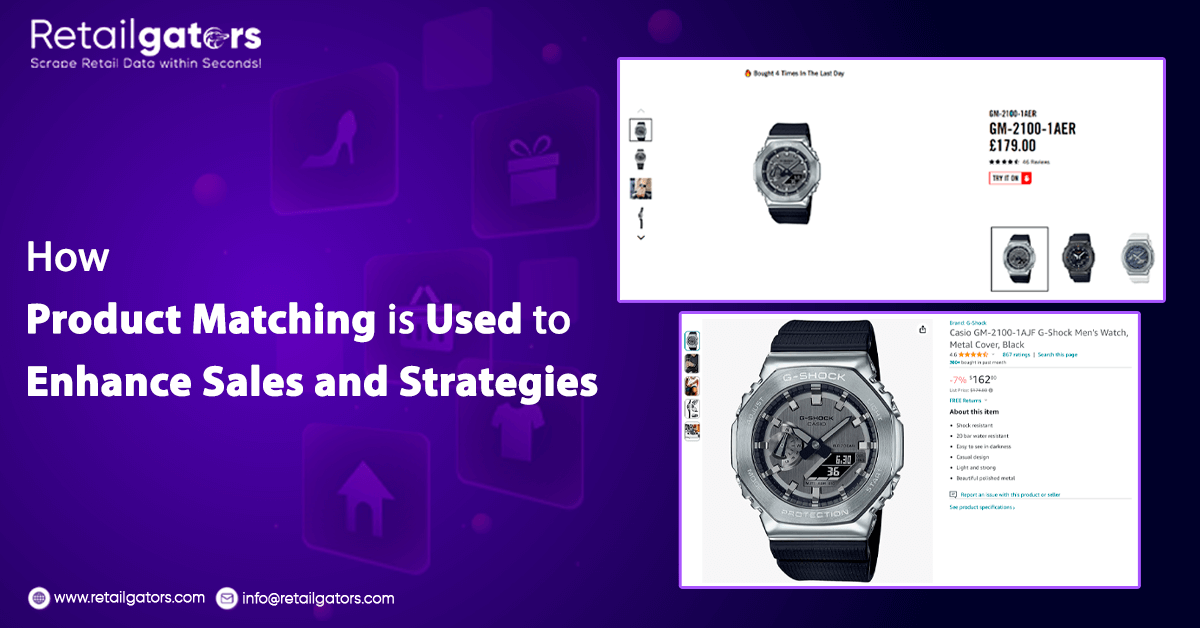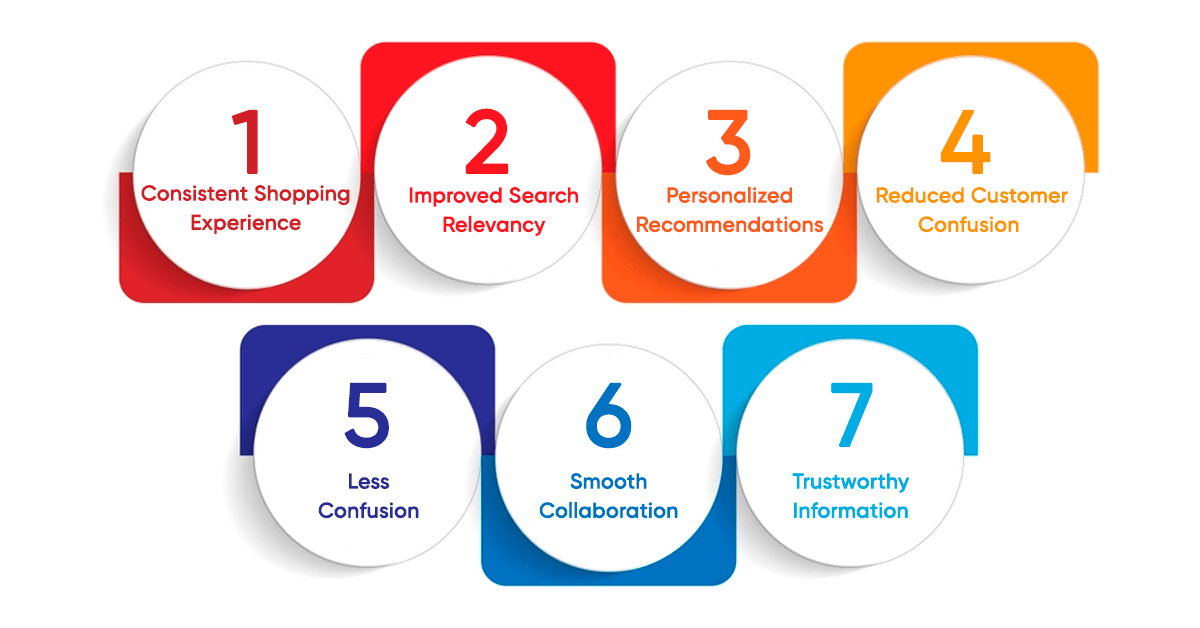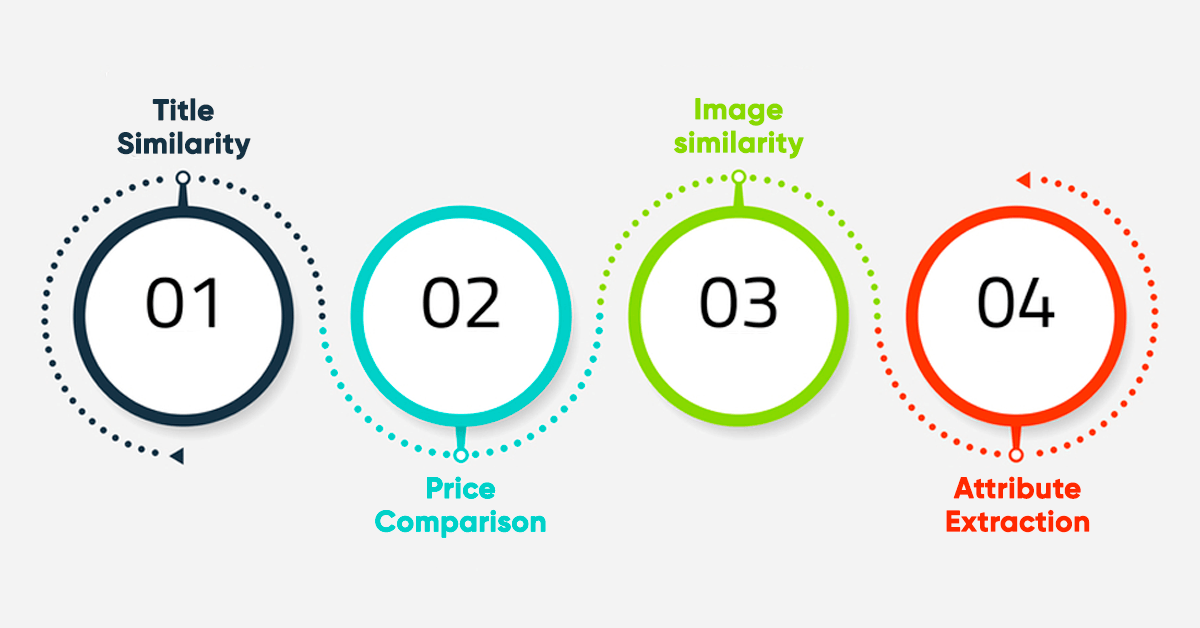
In the highly competitive world of e-commerce, where there is fierce competition at every step, and customer expectations are never-ending, product matching holds a powerful place that cannot be avoided in order for companies to stay in the competition. Product matching helps us find similar products on different lists. In turn, this helps companies to sell more, assists in marketing better, and increases the overall marketing experience for customers.
In this blog, we will discuss how product matching can be helpful and how to leverage the overall standing and performance of a company in the market.
What is Product Matching?
Product matching is comparing product features such as name, description, photos, and specs to determine whether two things are the same or comparable. This data can then be used to spot patterns, assess competitors, and make sound decisions regarding product pricing and marketing. Product matching can be done manually or by using automated tools and algorithms, but the purpose is to guarantee that the data is correct, up-to-date, and relevant.
For example, a store might have its products on its website and also on other sites like Amazon. Making sure the products look the same everywhere helps customers understand and makes it easier to manage the stock.
This consistency prevents consumer misunderstanding and allows the store to keep track of what they have in stock. As a result, when someone sees a product advertised on one site and then discovers it on another, they will immediately identify it. When everything matches, buyers can be confident in what they see, whether they're perusing the store's website or purchasing on another platform. Furthermore, it enables the store to manage its inventory better.
What is the Importance of Product Matching?

Product matching is extremely important in the world of e-commerce for various reasons:
Consistent Shopping Experience
Product matching guarantees that buyers see the identical product no matter where they search or what description they provide for the product they are willing to buy. Consistent product listings across platforms create a smooth purchasing experience, building customer confidence and loyalty.
Improved Search Relevancy
Search relevancy is critical in a large online marketplace. Effective product matching ensures that search results include relevant goods, boosting the chances of buyers discovering what they're looking for. This improves customer happiness and increases conversion rates.
Personalized Recommendations
Product matching allows merchants to assess client sentiment analysis efficiently. Understanding product similarities allows businesses to make individualized recommendations, increasing the relevancy of ideas and generating more purchases.
Reduced Customer Confusion
Inconsistent product listings cause confusion and dissatisfaction among customers. Product matching avoids confusion by continuously displaying the same or comparable items, lowering the probability of buyers quitting their purchasing trip owing to misunderstanding or doubt.
Less Confusion
Inconsistent product listings can be a headache for shoppers. Imagine searching for a pair of sneakers and finding them listed under different names or categories. Product matching eliminates this confusion by standardizing product data across all platforms. It means that you can trust that when you click on a product, you'll see the same accurate information no matter where you're shopping. This, in turn, helps customers to complete their purchase visit without getting confused and leaving the site.
Smooth Collaboration
Behind the scenes, product matching fosters better communication and collaboration between retailers and suppliers. By using standardized formats and data-sharing protocols, they can exchange product information more efficiently, reducing errors and delays. This not only benefits the businesses involved but also ensures a smoother experience for customers.
Trustworthy Information
When you're shopping online, trust is everything. Product matching helps build that trust by providing accurate and consistent product information in order to avoid the hassle of checking and matching the data from different sites. Whether it's the product name, description, or specifications, you can rely on the information you see, knowing it's been carefully matched and verified.
What are the Methods of Product Matching?
Product matching is considered an important practice in the e-commerce segment. It is important to evaluate different approaches to effective product matching. There are several methods used for product matching in eCommerce:
Rule-Based Method
A rule-based method finds matches that are based on defined rules and algorithms that are applied to particular situations. This approach has the benefit of being dubious, which makes the matching procedure more transparent and understandable. However, the rule-based approach provides more personalization and control. Users can modify the rules and algorithms to suit their own requirements. This flexibility allows for fine-tuning the matching process to ensure accurate and relevant results. We can tweak these rules to ensure the matches are appropriate, which helps ensure the best results. Plus, because everything is laid out clearly, it's easier to trust that the matches are fair and make sense. So, using this method helps make sure you get the right matches in a way that's easy to understand and trust.
Machine Learning (ML) Approach
In machine learning (ML) techniques, fresh cases are classified by training neural networks using known matches and non-matches. But occasionally, ML models can be hard to read, which makes it challenging to comprehend the reasoning behind certain matching decisions. On occasion, edge situations in the training data might also lead to untrustworthy outcomes. This opacity can make trusting the model's decisions challenging, particularly in sensitive applications like healthcare or finance. Moreover, the model may struggle to make accurate predictions in unfamiliar situations when the training data doesn't cover all possible scenarios. This highlights the importance of continually refining and updating machine learning models to improve their reliability and performance across various contexts.
Blending ML and Rules
Many of companies are using a mix of machine learning (ML) models and rule-based methods to fix any problems they might have with just using one method. This combination helps ensure that things match up more accurately while still keeping things clear and under control by following the rules. While rules aid in the understanding and management of correlations, machine learning is capable of handling more complex patterns that may be challenging to decipher with only rules.
This blended approach combines the strengths of both methods. With rules, everyone follows a clear set of guidelines, keeping things organized and predictable. Meanwhile, machine learning models act as intelligent assistants, spotting patterns and connections that may not be immediately obvious.
Which are the Models of Product Matching?

Product characteristics, photos, and titles are typically included in product data on the e-commerce marketplace. A product title is considered a short description that provides details about it. Typically, the product's features are presented in a structured and well-defined table or as a list of points. It might be simple for a buyer to discover comparable solutions if a competitor's picture is stolen. However, the strategy also lessens buyers' likelihood of being aware of what you have to offer.
The diverse product-matching approaches and models are as follows:
Title Similarity
An approach that is used for comparing offers by assessing the similarity of the titles is title similarity. Even when the comparisons are drastically different, technology can assist in discovering identical titles. The title of the identical product can vary from one vendor to another. A retailer's chosen model is used to determine related items.
Price Comparison
The similarity of products is mainly determined based on the pricing comparison. For example, specifically, there are several similar items with almost identical costs, but one offer differs from the others. This variation in price might indicate that the products are contrasting. Price distribution can be keenly considered and analyzed when determining comparable offers. When there is a resemblance between products, they are presented within a similar range.
Image similarity
The similarity between an image and a title functions similarly. Finding related items involves quantifying picture similarity. A primary obstacle in this case arises when the product has insufficiently labeled data points. The color, brightness, temperature, and other characteristics of the same product may also vary in the photographs. By understanding the importance of product matching, you can make the most of it to stay competitive.
Attribute Extraction
In this type of model, product match depends on the similarity of product categories. It can be item size, color, brand, model, condition, etc. Technology helps in measuring the level of difference between the products. If there is a low discrepancy, items are considered identical.
Strategies for Effective Product Matching
To ensure effective product matching in eCommerce, it is important to implement pre-framed strategies to ensure success in the e-commerce segment. Let’s evaluate several strategies that can be implemented:
Keep Things Consistent
Imagine you're writing a story and want to ensure all the characters' names are spelled the same way throughout the book. Similarly, with e-commerce, consistency is essential. We want to ensure that product names, descriptions, and other details are published consistently across many platforms. This uniformity allows us to compare items correctly and prevents misunderstanding for customers.
Give Product IDs
Think of product IDs as unique tags that we attach to each product. Just like you have a unique student ID or passport number, each product gets its own special ID number. This helps us keep track of them and make sure we're matching the right ones together. Plus, it makes it easier to organize and search for products in our database.
Look at the terms
Because computers are highly skilled at understanding language, we can use them to compare the terms in product descriptions to determine whether they are similar. For example, if one product is labeled as "blue jeans" and another as "denim pants," the computer will identify that they are essentially the same. This allows us to match items even when the terms are slightly different, making the matching process more precise and efficient.
Check for Mistakes
Product information should be checked for errors and missing details, like revising an essay before submission. We correct any errors or incompleteness in order to guarantee that the matching process runs successfully. This might include fixing spelling errors, filling in missing information, or updating out-of-date data. By keeping our product database accurate and thorough, we are able to prevent mistakes and give customers a better picking-up experience.
Work Together
Collaboration is key to success in any endeavor. In e-commerce, we team up with other companies to share product information and data. This way, we can access a broader range of products and match them more accurately. By working together, we can leverage each other's strengths and resources to improve the overall quality of our product-matching process.
Conclusion
Product matching in e-commerce is a fundamental aspect of e-commerce that directly impacts sales, marketing strategies, and overall customer satisfaction. It's all about making sure that when you look for something online, you find what you're actually looking for without any confusion.
Online businesses that provide consistent, accurate, and relevant product listings make shopping more accessible and fun for customers. Companies benefit from proper product matching services by RetailGators since it allows them to sell more products and remain ahead of their online competition. However, it is not enough to just present you with the appropriate items. Behind the scenes, corporations employ tactics and technology to ensure that their product matching game is effective. They employ clever algorithms, standardized data formats, and user feedback to improve and continuously enhance the online buying experience for everyone.








Leave a Reply
Your email address will not be published. Required fields are marked